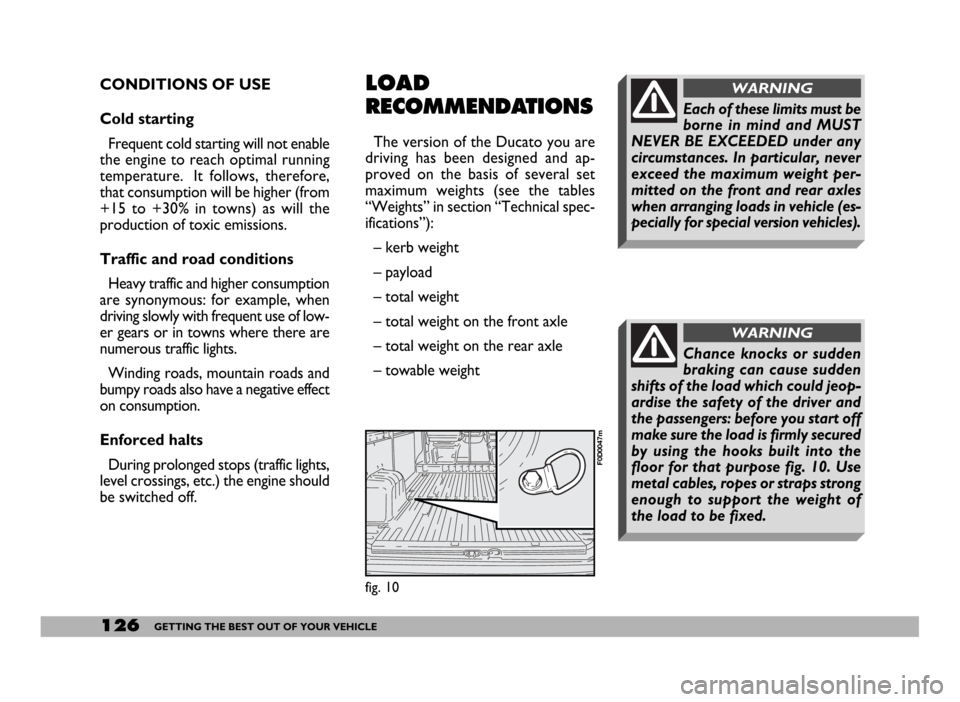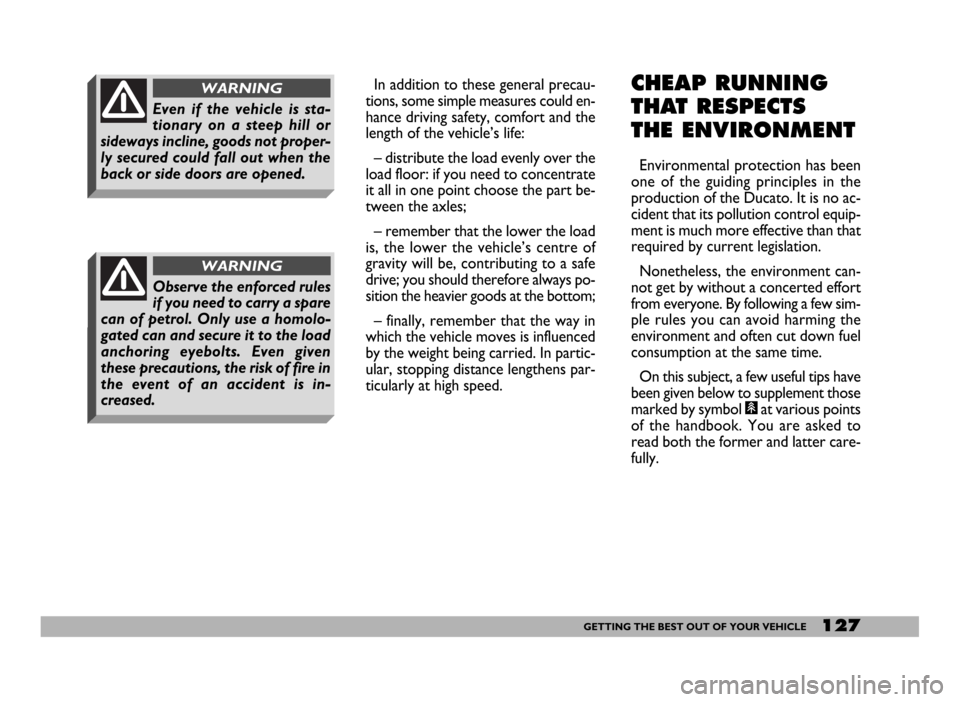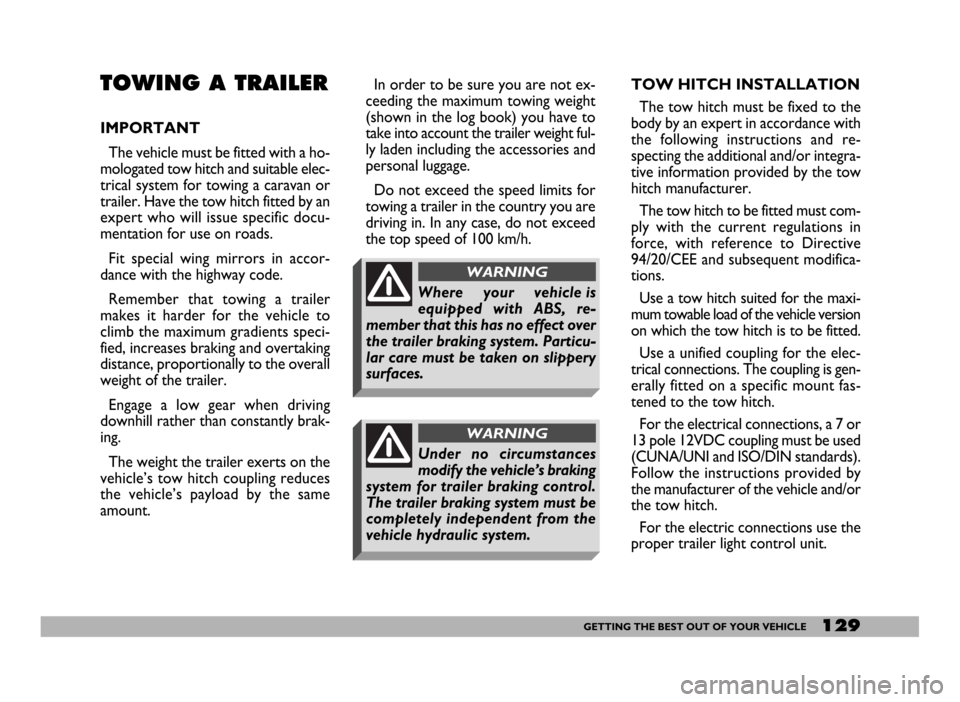2005 FIAT DUCATO 244 weight
[x] Cancel search: weightPage 125 of 258

124GETTING THE BEST OUT OF YOUR VEHICLE
To get the most out of ABS:
– During emergency stops or when
grip conditions are poor, you will feel
a slight pulsation on the brake pedal.
This is the sign that the ABS is work-
ing. Do not release the brake pedal but
continue to press so as not to inter-
rupt the braking action;
– ABS enables you to brake and steer
at the same time. If you meet an un-
expected obstacle you can therefore
steer around it;
– the ABS prevents the wheels from
locking but it does not increase actu-
al grip conditions between tyre and
road. Therefore, even if your vehicle
is fitted with ABS, keep a safe distance
from the vehicle in front of you and
keep your speed down when driving
into bends.
ABS serves to increase your control
over the vehicle, not to enable you to
go faster.Some suggestions which may help
you to keep the running costs of the
vehicle down and lower the amount
of toxic emissions released into the at-
mosphere are given below.
GENERAL
CONSIDERATIONS
Vehicle maintenance
Carry out the checks and adjust-
ments/regulations specified in the
“Service Schedule”.
Tyres
Check tyre inflation pressure regu-
larly. Tyres should be checked at least
once every four weeks: if the pressure
is too low, fuel consumption increas-
es as the resistance to the rolling
movement of the tyre is greater.Unnecessary loads
Do not travel with too much load.
The weight of the vehicle (specially in
urban traffic) and its trim greatly ef-
fects consumption and stability.
Roof rack/ski rack
Remove the roof or ski racks from
the vehicle as soon as they are no
longer needed. These accessories re-
duce the aerodynamic penetration of
the vehicle and will increase con-
sumption. When transporting partic-
ularly large objects, use a trailer,
where possible.CONTAINING RUNNING COSTS
Page 127 of 258

126GETTING THE BEST OUT OF YOUR VEHICLE
CONDITIONS OF USE
Cold starting
Frequent cold starting will not enable
the engine to reach optimal running
temperature. It follows, therefore,
that consumption will be higher (from
+15 to +30% in towns) as will the
production of toxic emissions.
Traffic and road conditions
Heavy traffic and higher consumption
are synonymous: for example, when
driving slowly with frequent use of low-
er gears or in towns where there are
numerous traffic lights.
Winding roads, mountain roads and
bumpy roads also have a negative effect
on consumption.
Enforced halts
During prolonged stops (traffic lights,
level crossings, etc.) the engine should
be switched off.LOAD
RECOMMENDATIONS
The version of the Ducato you are
driving has been designed and ap-
proved on the basis of several set
maximum weights (see the tables
“Weights” in section “Technical spec-
ifications”):
– kerb weight
– payload
– total weight
– total weight on the front axle
– total weight on the rear axle
– towable weight
fig. 10
F0D0047m
Each of these limits must be
borne in mind and MUST
NEVER BE EXCEEDED under any
circumstances. In particular, never
exceed the maximum weight per-
mitted on the front and rear axles
when arranging loads in vehicle (es-
pecially for special version vehicles).
WARNING
Chance knocks or sudden
braking can cause sudden
shifts of the load which could jeop-
ardise the safety of the driver and
the passengers: before you start off
make sure the load is firmly secured
by using the hooks built into the
floor for that purpose fig. 10. Use
metal cables, ropes or straps strong
enough to support the weight of
the load to be fixed.
WARNING
Page 128 of 258

127GETTING THE BEST OUT OF YOUR VEHICLE
In addition to these general precau-
tions, some simple measures could en-
hance driving safety, comfort and the
length of the vehicle’s life:
– distribute the load evenly over the
load floor: if you need to concentrate
it all in one point choose the part be-
tween the axles;
– remember that the lower the load
is, the lower the vehicle’s centre of
gravity will be, contributing to a safe
drive; you should therefore always po-
sition the heavier goods at the bottom;
– finally, remember that the way in
which the vehicle moves is influenced
by the weight being carried. In partic-
ular, stopping distance lengthens par-
ticularly at high speed.CHEAP RUNNING
THAT RESPECTS
THE ENVIRONMENT
Environmental protection has been
one of the guiding principles in the
production of the Ducato. It is no ac-
cident that its pollution control equip-
ment is much more effective than that
required by current legislation.
Nonetheless, the environment can-
not get by without a concerted effort
from everyone. By following a few sim-
ple rules you can avoid harming the
environment and often cut down fuel
consumption at the same time.
On this subject, a few useful tips have
been given below to supplement those
marked by symbol #at various points
of the handbook. You are asked to
read both the former and latter care-
fully.
Even if the vehicle is sta-
tionary on a steep hill or
sideways incline, goods not proper-
ly secured could fall out when the
back or side doors are opened.
WARNING
Observe the enforced rules
if you need to carry a spare
can of petrol. Only use a homolo-
gated can and secure it to the load
anchoring eyebolts. Even given
these precautions, the risk of fire in
the event of an accident is in-
creased.
WARNING
Page 130 of 258

129GETTING THE BEST OUT OF YOUR VEHICLE
TOWING A TRAILER
IMPORTANT
The vehicle must be fitted with a ho-
mologated tow hitch and suitable elec-
trical system for towing a caravan or
trailer. Have the tow hitch fitted by an
expert who will issue specific docu-
mentation for use on roads.
Fit special wing mirrors in accor-
dance with the highway code.
Remember that towing a trailer
makes it harder for the vehicle to
climb the maximum gradients speci-
fied, increases braking and overtaking
distance, proportionally to the overall
weight of the trailer.
Engage a low gear when driving
downhill rather than constantly brak-
ing.
The weight the trailer exerts on the
vehicle’s tow hitch coupling reduces
the vehicle’s payload by the same
amount.In order to be sure you are not ex-
ceeding the maximum towing weight
(shown in the log book) you have to
take into account the trailer weight ful-
ly laden including the accessories and
personal luggage.
Do not exceed the speed limits for
towing a trailer in the country you are
driving in. In any case, do not exceed
the top speed of 100 km/h.TOW HITCH INSTALLATION
The tow hitch must be fixed to the
body by an expert in accordance with
the following instructions and re-
specting the additional and/or integra-
tive information provided by the tow
hitch manufacturer.
The tow hitch to be fitted must com-
ply with the current regulations in
force, with reference to Directive
94/20/CEE and subsequent modifica-
tions.
Use a tow hitch suited for the maxi-
mum towable load of the vehicle version
on which the tow hitch is to be fitted.
Use a unified coupling for the elec-
trical connections. The coupling is gen-
erally fitted on a specific mount fas-
tened to the tow hitch.
For the electrical connections, a 7 or
13 pole 12VDC coupling must be used
(CUNA/UNI and ISO/DIN standards).
Follow the instructions provided by
the manufacturer of the vehicle and/or
the tow hitch.
For the electric connections use the
proper trailer light control unit.
Under no circumstances
modify the vehicle’s braking
system for trailer braking control.
The trailer braking system must be
completely independent from the
vehicle hydraulic system.
WARNING
Where your vehicle is
equipped with ABS, re-
member that this has no effect over
the trailer braking system. Particu-
lar care must be taken on slippery
surfaces.
WARNING
Page 139 of 258

138IN AN EMERGENCY
1. STOP THE VEHICLE
– Stop the vehicle in a position that
is not dangerous for oncoming traffic
where you can change the wheel safe-
ly. The ground should be flat and ad-
equately firm. If you have to change
the wheel at night, choose a lit area if
possible.
– Turn the engine off and pull up the
handbrake.
– Engage first or reverse gear.
– Alert other drivers that the vehicle
is stationary in compliance with local
regulations: hazard warning lights,
warning triangle, etc.
Any passengers should get out and
wait as far away as possible from the
danger of traffic.
If the road is sloping or bumpy, place
wedges or other suitable material to
prevent the vehicle from moving, un-
der the wheels.2. TAKE OUT THE TOOLS,
JACK AND SPARE WHEEL
The tools are in the cab near the
seats.
Please note:
– the jack weights 4.2 kg;
– the jack requires no adjustments;
– the jack cannot be repaired. If it
breaks it must be replaced with a new
jack;
– no other tool, apart from the ex-
tension and the ratchet wrench shown
in this chapter can be fitted to the jack.
The spare wheel is located under the
rear part of the load bed.
Do not lubricate the bolt
threads before fitting
them back: they could come
loose.
WARNING
Check tyre pressure and
spare wheel pressure regu-
larly. Refer to section “Technical
Specifications”.
WARNING
Page 178 of 258

177VEHICLE MAINTENANCE
ELECTRONIC
CONTROL UNIT
When the vehicle is being used nor-
mally, special measures are not nec-
essary.
The following instructions must be
followed very carefully however, if
you work on the electrical system or
in cases where emergency starting is
necessary:
– never disconnect the battery from
the electric system while the engine is
running;
– disconnect the battery from the
electric system if you are recharging it;
– never perform emergency starting
with a battery charger. Always use an
auxiliary battery;
– be particularly careful when con-
necting the battery to the electric sys-
tem. Make sure that the polarity is
correct and that the connection is ef-
ficient;
– do not connect or disconnect the
terminals of the electronic units while
the ignition key is at MAR;
– do not check polarity through
sparking;– disconnect the electronic control
units if you are electrically welding the
vehicle body. Remove the units if tem-
peratures exceed 80 °C (special op-
erations on the bodywork, etc.).
IMPORTANTIf the sound system
or vehicle alarm systems are not in-
stalled correctly, they can interfere
with the working of the electronic
control units.
Modifications or repairs to
the electrical system car-
ried out incorrectly and without
bearing the features of the system
in mind can cause malfunctions
with the risk of fire.
WARNING
SPEED LIMITER
On certain version, the injection con-
trol unit is set to limit the vehicle
speed at a max. preset limit.
Speed limits are the following:
– for Minibus versions (M2 homolo-
gation category): 100 km/h;
– for good Transport versions (ve-
hicle dead weight: > 3.5 t) (N2 ho-
mologation category): 90 km/h;
Label (fig.16) with admitted top
speed (90 or 100 km/h according to
versions) is applied on the wind-
screen.
This limit has been established by Eu-
ropean Directive 2002/85/EC, what-
ever violation is therefore punishable
by law.
IMPORTANTWhen the device
comes into action, the speed value
displayed on the instrument panel
could be approx. 10% higher than the
actual one.
fig. 16
F0D0299m
Page 187 of 258

186TECHNICAL SPECIFICATIONS
E- Maximum vehicle weight fully
loaded
F - Maximum vehicle weight fully
loaded with trailer
G - Maximum vehicle weight on
front axle
H - Maximum vehicle weight on rear
axle
I - Engine type
L - Body version code
M - Smoke opacity index (for diesel
engines).
This plate is fastened to the front
crossmember in the engine compart-
ment A-fig. 3.BODYWORK PAINT
IDENTIFICATION PLATE
The plateA-fig. 4 is set on the left-
hand inner side of the bonnet.It bears the following data fig. 5:
A - Paint manufacturer
B - Colour name
C - Fiat colour code
D- Respray and touch up code.
fig. 3
F0D0188m
fig. 4
F0D0189m
fig. 5
F0D0025m
Page 204 of 258

203TECHNICAL SPECIFICATIONS
Version 15
Chassis cowl 4050 wheelbase special Camping Car without EGR
Chassis cowl short wheelbase special Camping car
(max weight 1850 kg front axle)
Chassis cowl medium wheelbase special Camping car
(max weight 1850 kg front axle) without EGR
Chassis cowl long wheelbase special Camping car
(max weight 1850 kg front axle)
Chassis cowl 4050 wheelbase special Camping car
(max weight 1850 kg front axle)
Chassis cab short wheelbase without EGR
Chassis cab short wheelbase Camping Car without EGR
Chassis cab medium wheelbase without EGR
Chassis cab medium wheelbase Camping Car without EGR
Chassis cab long wheelbase without EGR
Chassis cab long wheelbase Camping Car without EGR
Chassis cab 4050 wheelbase without EGR
Chassis cab 4050 wheelbase Camping Car without EGR
Chassis cab medium wheelbase crew cab without EGR
Chassis cab medium wheelbase crew cab Camping Car without EGR
Chassis cab long wheelbase crew cab without EGR
Chassis cab long wheelbase crew cab Camping Car without EGR
Chassis cab short wheelbase special Camping Car without EGR
Chassis cab medium wheelbase special Camping Car without EGR
Chassis cab long wheelbase special Camping Car without EGREngine
2.8 JTD POWER
2.8 JTD POWER
2.8 JTD POWER
2.8 JTD POWER
2.8 JTD POWER
2.8 JTD POWER
2.8 JTD POWER
2.8 JTD POWER
2.8 JTD POWER
2.8 JTD POWER
2.8 JTD POWER
2.8 JTD POWER
2.8 JTD POWER
2.8 JTD POWER
2.8 JTD POWER
2.8 JTD POWER
2.8 JTD POWER
2.8 JTD POWER
2.8 JTD POWER
2.8 JTD POWEREngine
code
8140.43N
8140.43N
8140.43N
8140.43N
8140.43N
8140.43N
8140.43N
8140.43N
8140.43N
8140.43N
8140.43N
8140.43N
8140.43N
8140.43N
8140.43N
8140.43N
8140.43N
8140.43N
8140.43N
8140.43NBodywork
version
244BZMBG BYC
244BZMBA BYC1
244BZMBB BYC1
244BZMBC BYC1
244BZMBG BYC1
244BZMAA AY
244BZMAA AYC
244BZMAB AY
244BZMAB AYC
244BZMAC AY
244BZMAC AYC
244BZMAG AY
244BZMAG AYC
244BZMHB AY
244BZMHB AYC
244BZMHC AY
244BZMHC AYC
244BZMAA BYC
244BZMAB BYC
244BZMAC BYC